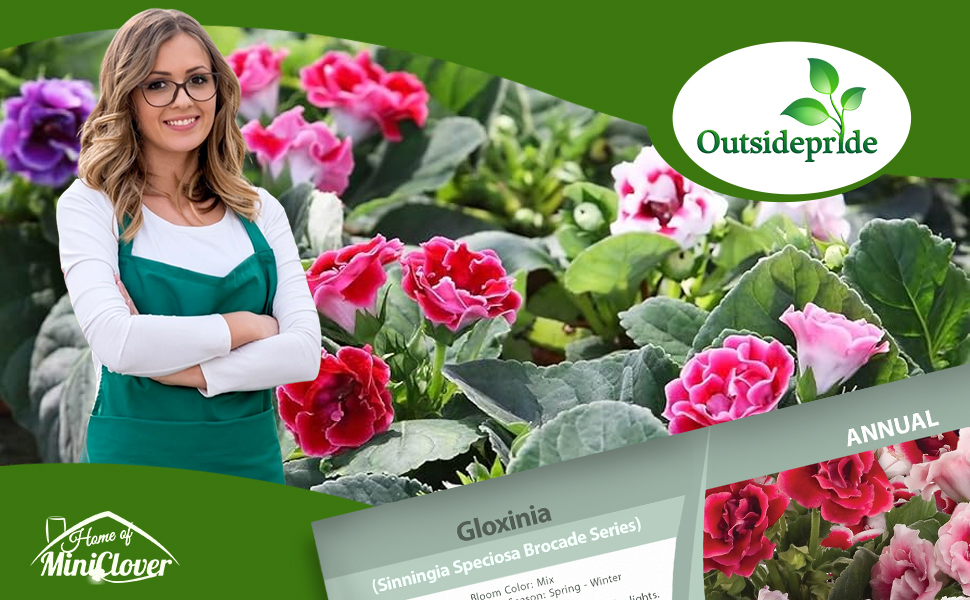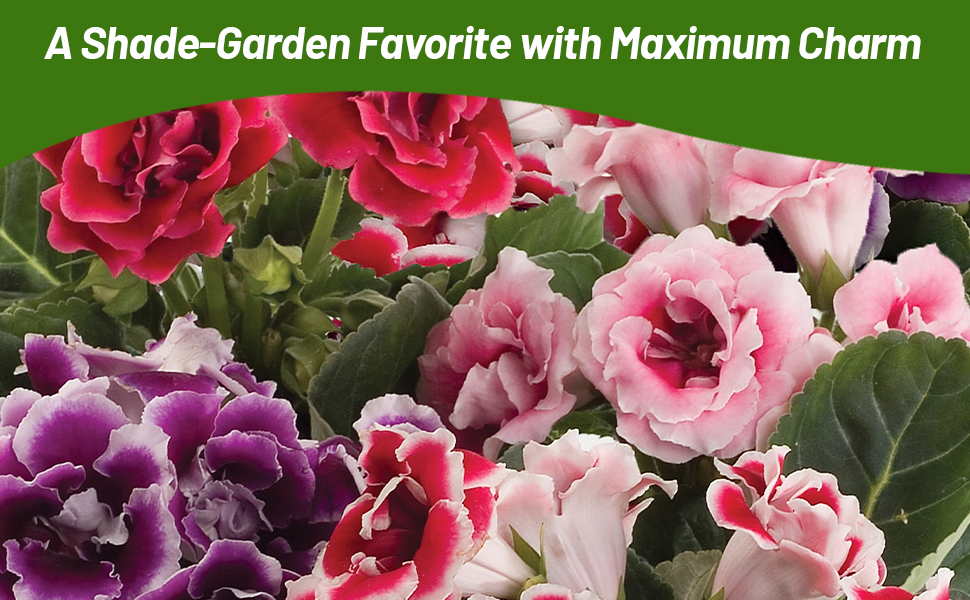-
CATEGORY ::
- All Seeds /
- All Flower Seeds





Clematis Seeds
SEASON
Perennial
USDA ZONES
5 - 9
HEIGHT
80 - 96 inches (vining)
BLOOM SEASON
Summer and fall
BLOOM COLOR
Yellow
ENVIRONMENT
Full sun
SOIL TYPE
Well-drained, pH 6.5 - 7.5
DEER RESISTANT
Yes
HOUSE PLANT
No
SEASON
Perennial
USDA ZONES
5 - 10
HEIGHT
10 inches
BLOOM SEASON
Spring through winter
BLOOM COLOR
Mix
ENVIRONMENT
Partial shade
SOIL TYPE
Well-drained, pH 6.1 - 7.5
DEER RESISTANT
Yes
HOUSE PLANT
Yes
LATIN NAME
Sinningia speciosa
SEASON
Annual
USDA ZONES
4 - 10
HEIGHT
6 - 8 inches
BLOOM SEASON
Mid spring to late summer
BLOOM COLOR
Mix
ENVIRONMENT
Full sun
SOIL TYPE
Best in rich, well drain soil
DEER RESISTANT
No
LATIN NAME
Leptosiphon hybrida
SEASON
Perennial
USDA ZONES
7 - 11
HEIGHT
28 inches
BLOOM SEASON
Spring to fall
BLOOM COLOR
Rosy purple
ENVIRONMENT
Full sun to partial shade
SOIL TYPE
Well drained soils, pH 6.6 to 7.5
DEER RESISTANT
Yes
SEASON
Perennial
USDA ZONES
7 - 11
HEIGHT
4 inches
WIDTH
12 - 18 inches
BLOOM SEASON
Early spring to early fall
BLOOM COLOR
Pink
ENVIRONMENT
Full sun to partial shade
FOOT TRAFFIC
Light
DEER RESISTANT
Yes
SEASON
Annual
USDA ZONES
3 - 11
HEIGHT
100 - 140 inches
BLOOM SEASON
Late spring to late summer
BLOOM COLOR
Mix
ENVIRONMENT
Full sun
SOIL TYPE
Well drained, pH 6.6 - 7.5
DEER RESISTANT
No
HOUSE PLANT
No
SEASON
Annual
USDA ZONES
4 - 9
HEIGHT
12 inches
BLOOM SEASON
Late summer to early fall
BLOOM COLOR
Mix
ENVIRONMENT
Full sun
SOIL TYPE
Moist, well-drained, pH 6.6 - 7.3
DEER RESISTANT
Yes
SEASON
Perennial
USDA ZONES
9 - 11
HEIGHT
120 inches
BLOOM SEASON
Mid summer to late fall
BLOOM COLOR
Orange, red, yellow
ENVIRONMENT
Full sun
SOIL TYPE
Sandy, well drained soil, pH 5.5 - 7.5
DEER RESISTANT
Yes
LATIN NAME
Mina lobata
About...
Clematis (Clematis Tangutica) - Clematis seeds produce a wonderful, vining flower that is a long-lived perennial, normally living at least 25 years. The top of the Clematis vine should be exposed to full sunlight with the roots shaded by either a ground cover or a mulch such as bark dust.
MORE FLOWER OPTIONS
Planting Directions
TEMPERATURE
68F
AVERAGE GERM TIME
21 - 28 days
LIGHT REQUIRED
Yes
DEPTH
Do not cover
SOWING RATE
6 seeds per plant
MOISTURE
Keep moist until germination
PLANT SPACING
48 inches
Clematis (Clematis Tangutica) - Clematis seeds produce a wonderful, vining flower that is a long-lived perennial, normally living at least 25 years. The top of the Clematis vine should be exposed to full sunlight with the roots shaded by either a ground cover or a mulch such as bark dust.
Great for trellises
This vine is great for trellises and arbors, and also does well in containers as an annual. This Clematis plant will both summer and fall. Sometimes it is called Golden Clematis.

Clematis seed |
How to grow
How To Grow Clematis From Seed: Before sowing Clematis seed, refrigerate the seed for 2 - 3 weeks. Some gardeners prefer to start the flower seed outdoors in the late fall or in the winter in a cold frame. The cold helps to break the dormancy.
Clematis flower seed takes about 21 - 28 days to germinate. You can sow the flower seeds in trays indoors and transplant the seedlings after frost season, or sow the flower seeds directly outside after danger of frost has passed.
- Sowing Rate: 6 seeds per plant
- Average Germ Time: 21 - 28 days
- Keep moist until germination
- Depth: Do not cover

Flower Specifications
Clematis Tangutica is tolerant of poor soil but needs to be well watered. This Clematis plant will flower within 3 - 4 months of planting the flower seeds, and the second year it will produce significantly more blooms. The 3 inch yellow blooms also produce feathery silver seed heads.
- Height: 80 - 96 inches (vining)
- USDA Zones: 5 - 9
- Season: Perennial
- Deer Resistant: Yes
Common Questions
How do I know when to prune my clematis tangutica?
Prune hard in late winter; cut back to a pair of strong buds above 1 foot. Prune less severely if early spring flowers are desired.
Will clematis damage the shrubs it climbs over?
Clematis is not as heavy a vine as wisteria, so it won't harm shrubs with its weight. If the foliage is dense, try to spread it out to avoid blocking the shrub's leaves completely.
Why is my clematis not blooming?
Clematis requires a soil that retains moisture but is well-drained. The roots should be kept cool while the top part needs sunlight to thrive and produce flowers. Avoid over-fertilizing and ensure it is not in competition with weeds for water and nutrients. Improper pruning at the wrong time of year can also hinder blooming.
Planting Directions
TEMPERATURE
70 - 75F
AVERAGE GERM TIME
21 - 28 days
LIGHT REQUIRED
Yes
DEPTH
Do not cover the seed but press into the soil
SOWING RATE
4 seeds per plant
MOISTURE
Keep seed moist until germination
PLANT SPACING
10 inches





Gloxinia (Sinningia Speciosa Brocade Series) - Sow Gloxinia seeds to produce a beautiful mixture of red, blue, and white blooms. These compact Gloxinia plants blossom four to six months after sowing. They will flower for about 2 months, go dormant for about 2 months, and then begin growing again and start flowering. Gloxinias make a great house plant, giving wonderful, colorful blooms! Sinningia Speciosa is often referred to as Florist's Gloxinia or Brazilian Gloxinia.
Gloxina seeds are a bit tricky to germinate and do best indoors and under lights. Do not cover the flower seeds after sowing since they need light to germinate. Sinningia Speciosa seeds should germinate in about 3 weeks at 70 - 75F degrees. Soil should be kept uniformly moist, but do not keep it saturated. Florist's Gloxinia care includes avoiding watering the crown of the plant as this might cause the plant to rot, and use water that is at room temperature for watering. The Brazilian Gloxinia plant needs lots of light, but no direct light. Gloxinias do best in temperatures around 65 - 75F degrees, especially when they are blooming. After blooming, keep watering to a minimum and don't fertilize.
Common Questions
Do I need to prune my gloxinia?
To encourage a longer bloom season, you will need to deadhead your spent flowers. After the bloom period is over and your plant enters dormancy, prune back any dead or dying foliage.
My leaves are dropping, what do I do?
This can occur from sudden temperature changes such as drafts.
My leaves look scorched, why?
Direct sunlight can burn the leaves of your gloxinia, causing them to scorch and crisp.
My flowers are losing their vibrancy, what do I do?
This is typically caused by inadequate light move your plant to an area with more light but not direct sunlight.
Planting Directions
TEMPERATURE
55 - 65F
AVERAGE GERM TIME
14 - 21 days
LIGHT REQUIRED
Yes
DEPTH
Surface sow seed and light cover no more than 1/8 inch deep
SOWING RATE
3 - 5 seeds per cell or approximately 5000 seeds covers 100 square feet
MOISTURE
Keep seeds moist until germination
PLANT SPACING
8 inches
Leptosiphon Mix (Leptosiphon Hybrida French Hybrids Mix) - Start Leptosiphon seeds to start these dainty little flowers. Leptosiphon French Hybrids has the synonymous botanical name Linanthus androsaceus. This low-growing annual has fern-like foliage and hundreds of sweet little half inch star-shaped flowers that shine out from the foliage. The colors are mixed and bright in shades of rose, yellow, orange and cream. Leptosiphon uses include edging the front of the flower bed, containers, edging a pathway, or as a ground cover. Commonly known as False Baby Stars, this annual is lovely if it is allowed to spill over the edges of rocks or containers. It makes a carpet of color and is stunning!
Grow Leptosiphon seeds directly outside in a prepared seedbed after frost danger has passed. Press the flower seed into the soil and lightly cover. False Baby Stars flowers perform best in full sun, and they prefer rich, well-draining soil.































